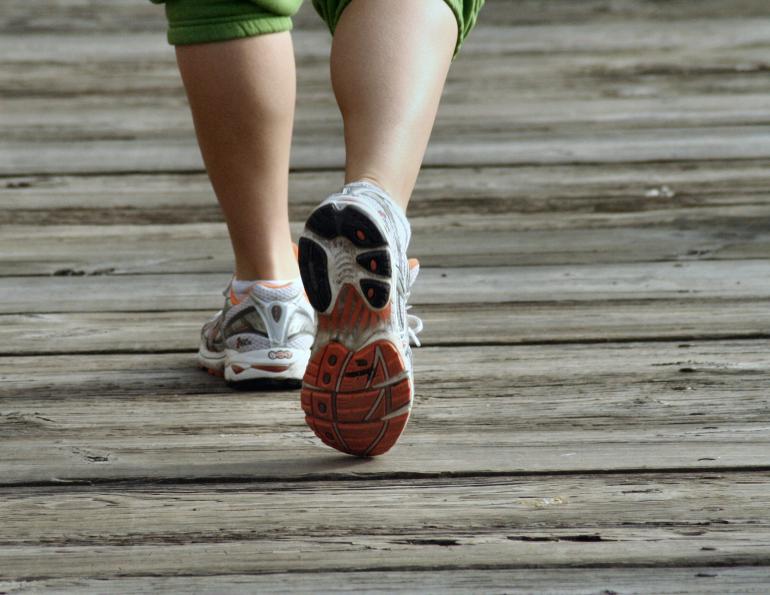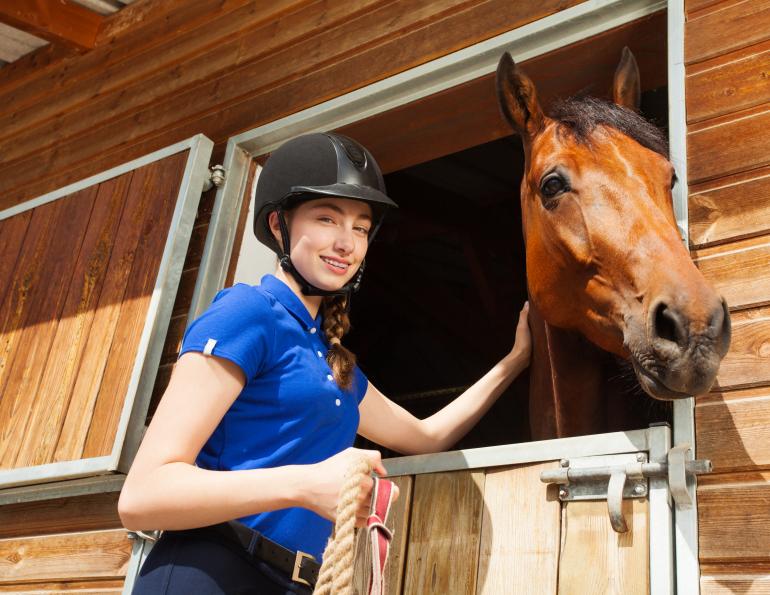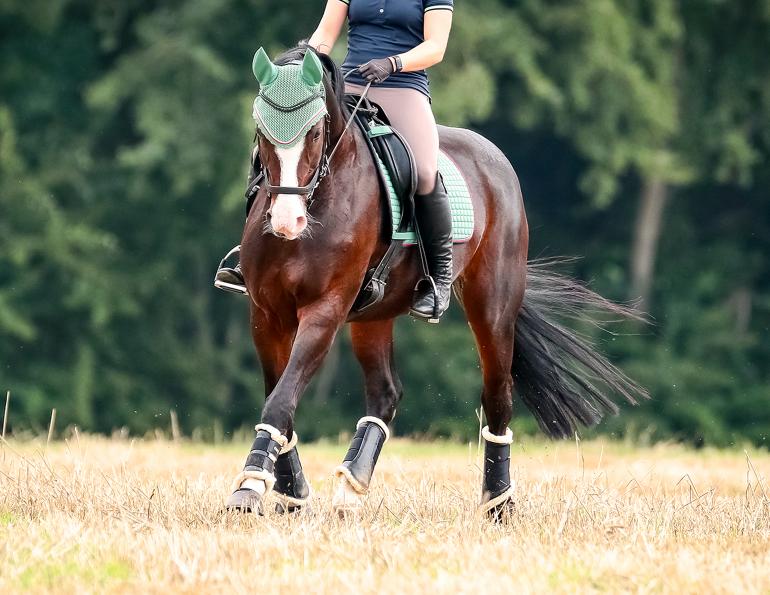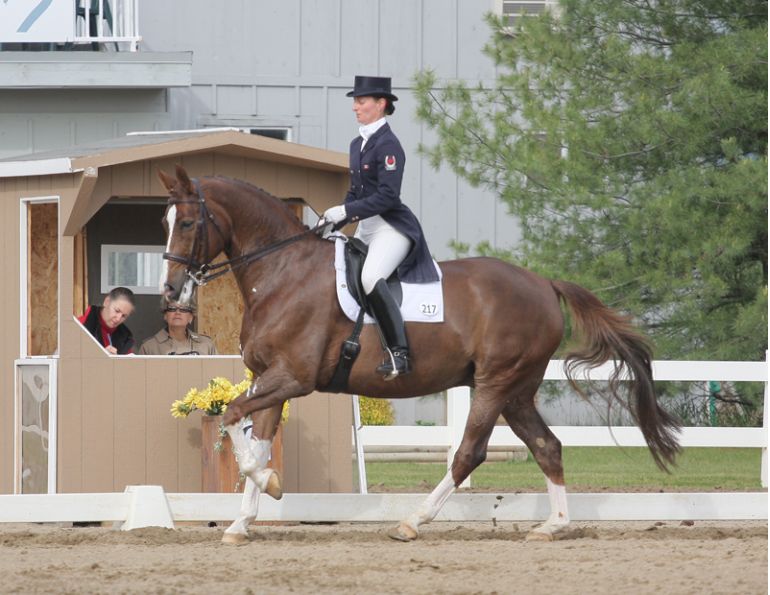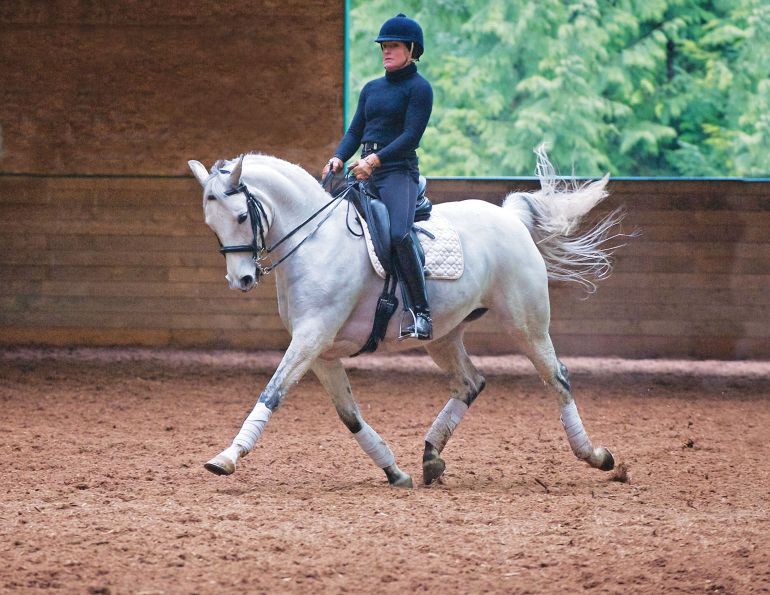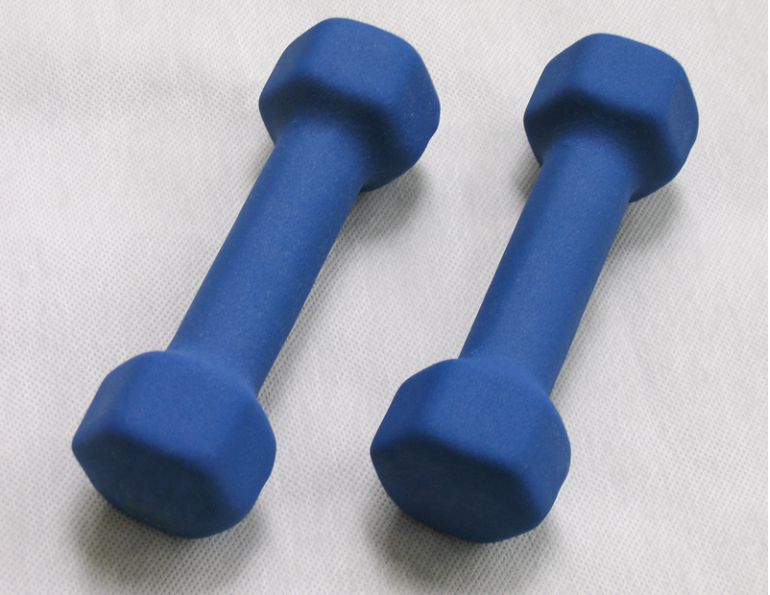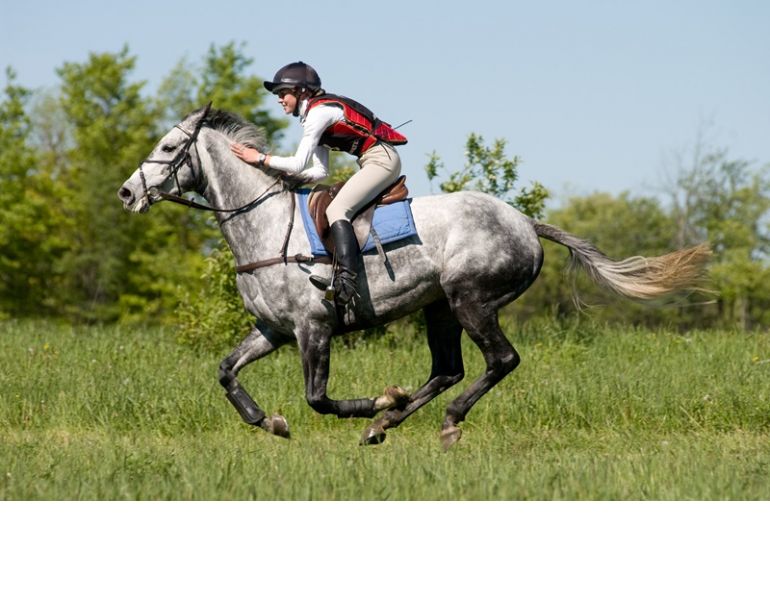Interviewed by Heather Sansom
In "How the Pros Stay Fit to Ride, Part 1," I interviewed some of our top Canadian dressage riders to see what they did to cross-train for riding. In this article, I am happy to bring you interviews with top Canadian show jumpers Amy Millar and Amanda Hay.
Millar, 32, is the daughter of Canadian Olympian Ian Millar. She was a Young Rider silver medalist in 1996 and has competed for Canada internationally since 1999. She has a Bachelor of Commerce degree from Ryerson University in Toronto and works full-time with the family business, Millar Brooke Farm in Perth, Ontario, training horses, coaching, competing, and doing clinics.
Amanda Hay, a top national and international show jumper, and her horse Nero. Photo: Courtesy of Amanda Hay
Hay, 37, has competed internationally for Canada in show jumping at the Grand Prix level. In 1999, she competed in Cannes on her Grand Prix horse Nero. She started riding at the age of five and competing at the age of eight. She is based near Ottawa, Ontario at her farm Elmcroft Equestrian Centre, where she specializes in training young prospects and preparing riders for the A circuit in hunters and jumpers. One thing that really stood out for me as I conducted the interviews was the fact that it did not seem to matter whether I was speaking with a dressage rider or a jumper; both agreed that making time to cross-train is vitality important to their riding performance.
When I am working with riders in a clinic or individually, the training programs I recommend do differ somewhat depending on discipline. For example, we know that fitting up a horse for eventing takes a large volume of time because of the extreme requirements for ligament strength, cardiovascular ability, and muscular endurance. An event rider needs a corresponding program to address these same issues. Even though all riders need to train cardiovascular ability off horse in order to push the envelope sufficiently for results, an eventer’s cardiovascular training time would exceed the requirements for a dressage rider.
Another example is core strength. Because our base is on the horse and not on the ground, riders need the kind of core stability and agility of a dancer. We do not use our stirrups for stability, since doing so would block the effectiveness of our leg aids. We use our balance. Balance is maintained through self-carriage, whether that is in the dressage ring or over a Grand Prix fence.
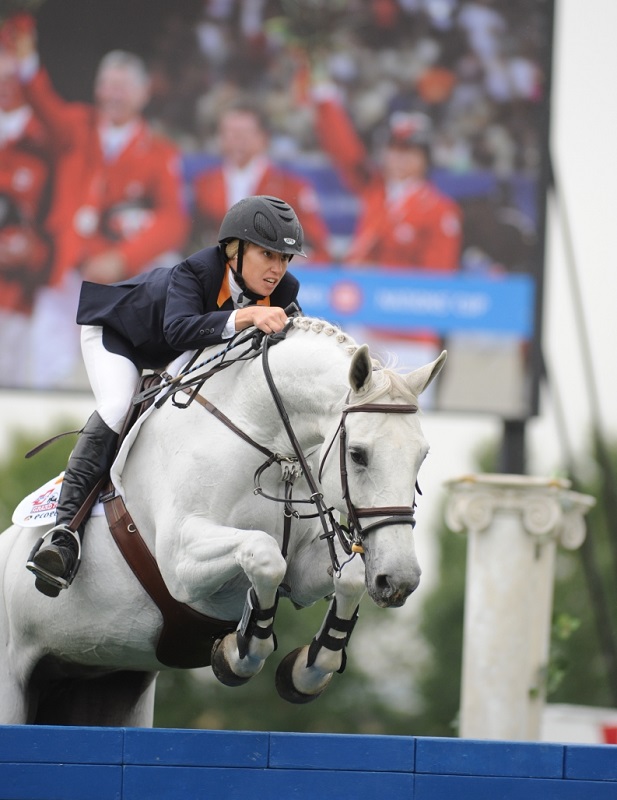
Self-carriage is just as important for the show jumper as the dressage rider. Suppleness, core strength, and endurance are other important areas to cross-train. Amy Millar is shown riding Costa Rica Z at Spruce Meadows in 2008. Photo: Robin Duncan Photography
In dance and martial arts, your centre of support is not really in your feet either, since they may leave the ground in any direction, at any time (or that is the ideal). As with dance or martial arts, riders need to operate our hips, shoulders, and limbs independently of our horse. When we try and use the horse’s body to stabilize ourselves, we impose a blockage or uneven load and compromise his movement.
To the average observer, it looks like a jumper rider is sitting on the horse’s back and the horse is carrying them over the jump.
Yet, in my interviews with high level jumper riders, as much emphasis is placed on self-carriage as with dressage riders.
That’s because if you look closely at a horse jumping, you actually see a lot of movement in his back: the collection, leap and reach, the bascule over the fence, a possible extra hike of the hind end in mid-air, and then a reverse collection from his shoulders with transfer of weight back to hind end on landing. The rider who interferes with their horse’s back simply cannot make the heights, turns, or combinations required past a certain level.
The high level jumper rider has to be able to follow the movement through without impedance from hand, leg, seat, or bodyweight. Just as with the jumping horse, the jumper rider needs a high degree of leg, gluteal, and back strength to resist the forces of gravity in each phase of the jump: up, mid-air, and down. The rider also needs very precise control of limbs and weight for negotiating a course while optimizing their horse’s abilities.
Also similarly to their mounts, jumper riders need suppleness and a high degree of strength and stamina in key areas. Again, the comparison to martial arts and dance is a good one here, because you can visualize the strength-suppleness combination.
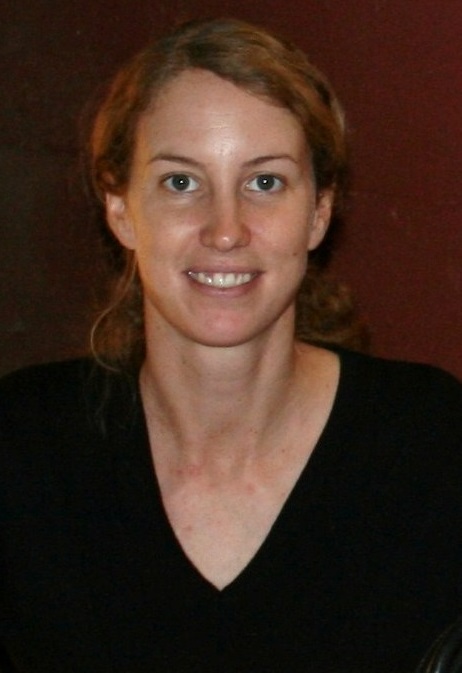
Amy Millar is the daughter of Olympic show jumper Ian Millar. She has been competing internationally for Canada since 1999. Photo: Kalina Rutledge
Heather Sansom: What types of activities do you do to cross-train for riding?
Amy Millar: I do a core workout everyday for about half an hour. I used to do pilates more regularly, but it’s hard to find time to go to a class. In addition to my core routine, I also stretch every day because lower back suppleness is critical to correct riding.
Amanda Hay: I row on my rowing machine for 15 to 30 minutes, four times a week. I also do yoga for an hour and a half once a week and play soccer for my cardio once a week. I have to be careful with the soccer because the risk for injury is relatively high, and I can’t afford to have a cross-training activity affect my riding negatively.
I am not much of a runner, so I found the rowing helped me work on my cardio, while also working my back strength, core strength, and opening up the chest area muscles. I have done pilates in the past. I find it’s excellent for riding and there have been times when I have sent students to take pilates to work on their core.
HS: Why is making time to cross-train important to you?
AH: We are athletes and we have to treat ourselves as athletes. A lot of riders don’t. It’s really important to have body control, especially when you are jumping. Since I have been riding for 30 years, I sometimes have issues with my knees. That’s why I don’t like to run. But I need to find things to do to keep my knees in good shape so that issues don’t end up compromising my ride.
HS: What changes have you experienced physically over the years as far as the demand riding makes on you physically?
AM: I think it’s really important to be strong in the core and to stretch and stay limber. You can put your back out (I’ve done it) because of a stiff neck for example. As a professional athlete, I can’t afford to have things happen like muscle spasms or knots when I’m riding. Over the years I’ve learned that it’s really difficult to compete under pain, so the more prevention you can do, the better.
HS: Is there anything you wish you had known about early with regards to your athletic training?
AM: I wish I’d known about pilates a long time ago. It really helps with learning to move parts of your body separately from each other, while others stay stable. It also helps with balance which is so critical to everything we do. For example, you may need to resist the horse’s mouth a little while maintaining a soft elbow. A lot of riders would just stiffen up the whole arm. You have to have very precise control. Sometimes, I tell students to go and get fit. When they do, their riding has improved tremendously.
HS: Can you talk a bit about the specific demands being a jumper and coach makes on your body?
AH: Staying up out of the saddle so much can lead to overdevelopment of the quadriceps. Sometimes when I have been slack with cross-training, that happens for me and I think it is part of the issue with my knees. I have to train my hamstrings to help balance things out, and the rowing helps. It doesn’t really matter whether you jump three feet or five feet — you really need to be able to carry yourself. If you don’t have a strong core and strong legs, you end up going to your hands for balance.

Hay recommends that older riders work on flexibility and cardiovascular endurance.
Riding from your hands inverts the horse, which is the last thing you want. You need them to bascule. You need to be able to hold yourself up, so you aren’t falling on their back, shoving them forward, or throwing them off to the side.
Now that I spend more time teaching than I do in the saddle, I find I need to do a little more cross-training. That’s another reason I got the rowing machine. You need to stay flexible as a rider, but also maintain long, lean, strong muscles. Because I’m so tall, I have always been aware of the need for good body control.
As a rider, it’s important to manage your other sport involvements so you don’t get hurt. Riding is such a large investment in time and resources for any rider. You need to cross-train to get the most out of it, but not to the point where you injure yourself and can’t ride.
The other really important area is diet. Without going overboard, you need to think about food in terms of energy and fuel.
I know I need to do that now that I’m in my 30s — more so than when I was younger. I pay attention to what I eat to feed my muscles. I know if I don’t, my body will crash partway through the day. I do smoothies in the morning because I’m not a big breakfast eater. I also pay more attention to protein now. If you don’t fuel regularly, especially on a show day, you’ll crash. You’ll get lost on course because your mind won’t work properly. That’s when accidents happen. Mental alertness gets cut in half when you haven’t been eating or drinking through the day.
HS: With your busy schedule and all the travel you do, why is it so important for you to make time for your personal exercise — you must burn thousands of calories a day with the riding, so clearly it’s not about weight.
AM: You have to be as strong as you can be, especially in the core. Having a strong core makes your position stronger and helps you position your body effectively in motion. When you are also as loose and limber as you can be in the lower back, you can have better technique. With a strong position and good technique, you don’t fall into trying to muscle the horse.
HS: How do you stay fit on the road?
AM: Competition takes a lot of physical, mental, and emotional energy. I do what I do with my horses: concentrate on conditioning at home and on soundness while in competition.
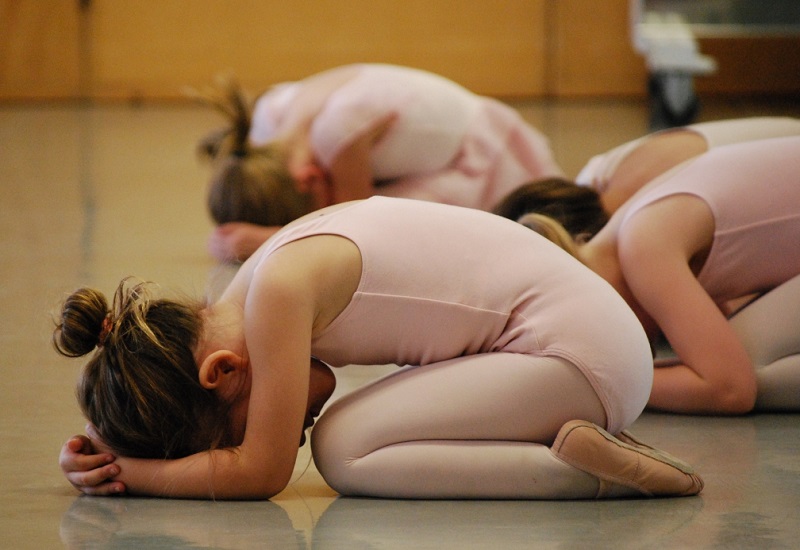
Dance or gymnastics are beneficial for horseback riding youth as they teach core strength, balance, and rhythm.
HS: Do you have any advice for parents with kids who ride, or for adult amateurs?
AM: Find something you enjoy doing — that way you’re more likely to keep it up. When kids are younger, it’s good to play other sports. I played team sports when I was a kid. If you’re serious about riding, you have to make the lifestyle changes to be fit, strong, have proper balance, and eat healthy. I’m an active person — all day I keep moving — so I don’t need to look for cross-training opportunities to burn calories. My cross-training is supplementary to activities I do. A more sedentary person might need to look for more opportunities to bring their general activity level up, as well as specific work to help their riding.
AH: Be active. Gymnastics and dance give kids core strength, balance and rhythm. I can see the difference even at seven years old when I am starting a new student. The ones that have done or are doing dance or gymnastics have more natural balance, posture, and coordination. Also, students who do other sports into their teens usually have better hand-eye coordination. With jumping, hand-eye coordination is really big because in jumping you are dealing with speed, distance, and physics for placing a horse correctly before a jump.
For the adult amateur, work on flexibility and cardio. Many older riders are stiff through their back and hips, so they have difficulty getting their leg down and around the horse. They also need to have good enough cardiovascular endurance to get around a course without getting winded.
To read more by Heather Sansom on this site, click here.



